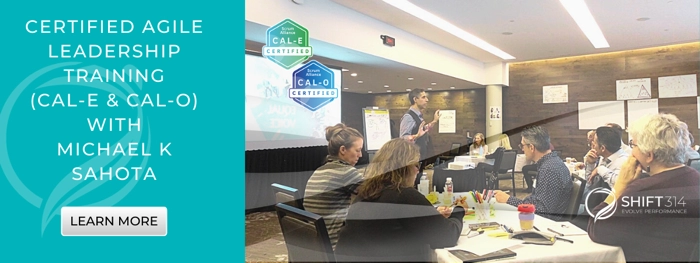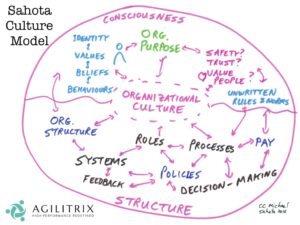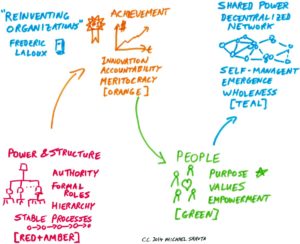You will learn How to Change Your Organizational Culture. Yes. How to Change Your Culture. It requires effort and focus. And it is possible. I have done it and leaders around the globe have applied this same information to change their culture. What follows below is an outline of the proven steps. I also include pointers to supporting resources.
1. Desire for Growth
The starting place for culture change is desire – a powerful urge to create change. Nothing less than this will result in success. So that is the starting place. Anyone interested in shifting culture needs to look inside to see what is driving them and make sure they have motivation to do the work needed. I used to subscribe to Kotter’s “Sense of Urgency” and even advocate this. I no longer do. It turns out that Urgency linked to fear and a lower level of psychological safety. This inhibits personal and organizational growth. For this key reason, “Desire” is a better choice.
Strong Desire for Growth is Essential
Organizations that have sustained organizational growth over decades see improving as part of everyday work. They invest in growth because it is important. It’s the right thing to do. Not because of urgency.
2. Understand Existing Culture
The next step is to understand your existing culture. But what is Culture? We can define it as “How we do things around here”. I have experimented with a lot of culture models and recommend the two that are proven in terms of simplicity and power. You can use them together to diagnose and your culture and orient for growth. The Sahota Culture Model provides a clear understanding of culture through identification of the interconnected elements that shape culture. It also highlights the need to focus not just on Structures but also on the Consciousness (or Mindset) of a system. We often fall into the trap of focusing on structures (especially process) rather than focus on the people and how they are working together. This model reminds us that it’s really about the consciousness (or mindset), the people, not about the structures or process. The other model that is very powerful is a modified version of the Laloux Culture Model. It may be used to assess where the organization is right now. It also has the tendency to help spark a desire for shifting to a higher performance way of working such as Green or Teal. One key reason to use this model is that it has heaps of case studies and research to support the claims of high performance. It also lines up with many other models and theories of culture and behaviour such as McGregor’s Theory X – Theory Y.
3. Create a Star on the Horizon
The next step is to look at case studies and examples of the kind of company that you want to become. There are lots of great resources such as the book “Reinventing Organizations” or Diverse Paths to High-Performance Organizational Culture. It is a good idea to use these for inspiration. The goal is to create a “Star on the Horizon” that is aligned with the desire for change. Don’t try and copy structures. Copying simply gives you the structures without the shift in culture.
Find Your Own Path.
The secret here is to find your own path. Selecting a path is primarily a function of two things: 1. The existing situation in your organization. We can only grow and evolve from the place we are at. 2. The shared desire of people to create a new future. The desire could just be top leadership, or they may co-create this with people throughout the organization.
4. Culture Grows Locally
A common misconception is that culture change is for the whole organization. It is important to understand that in most organizations culture varies by team, department, and location. It is as unique as each individual manager. So, keep in mind this key point:
Culture is a local phenomenon.
Since it is a local phenomenon, it means that it is possible to make changes locally within your part of the organization. The most common way for culture to grow is Culture Bubbles. Of course, when we do this, there will be culture gaps that create tension and challenges. The key idea for reducing the tension is to Build Culture Adapters. There will be different ways of working and different values inside the bubble and outside the bubble. The adapter idea is to reduce conflict with the rest of the organization by building adapters between the ways of working. It’s a key pattern for creating sustainable culture bubbles.
5. Leaders Go First
Culture is primarily a reflection of Leadership. What happens at the bottom of the organization is a fractal of what happens at the top of the organization. (Thanks to Glenda Eoyang for this wisdom). It is well known that the performance of a team is a direct reflection of their manager – this was proven through validated real-world research almost 20 years ago through the Gallup 12 “Engagement” Questions.
Culture Change is Not Delegable
The way to change culture is for leaders to change how they interact with people and the organizational system. A key concept here is that Organizational Behaviour Follows Leadership Behaviour. A new kind of organizational behaviour way of working requires that leaders behave in a new way of working. So successful transformation requires that Leaders Go First!

6. Leadership Growth is Required
A key lesson in my career is that the Leader is the Limit for Growth. I notice that to create high performance organizational systems, leaders needed to develop themselves as human beings. They needed to grow into the kind of leaders we see in high performance environments. This means inner work cultivating trust, safety, and connection. As leaders we need to get our egos under control so we can develop leaders around us. This is not for the faint of heart. We are talking about developing ourselves not just as leaders but as human beings. Like you, I am on this journey too. I created the 4A’s Conscious Leadership Model to capture the step-by-step approach I have been using to grow myself. It’s a powerful tool to help rewire our unconscious behaviours that are preventing us from showing up as the leader we desire to be. We are so deeply conditioned by society to have behaviours that are contradictory to high performance. Dedicated focus and effort is required to shift our habits and unconscious behaviours.
A learning organization is a place where everyone grows.
Remember the desire for organizational growth in step 1? This is where you need it. Personal growth requires a strong drive to keep up the effort. This is the secret of changing culture: All we need to do is change our behaviour and culture will follow.
It’s a Journey
The above steps are sufficient and necessary for culture change in an organization. What is shared here is the key starting elements for culture change. Or course there are a lot more details on how to do the steps outlined here and even more on supporting the journey.
You Can Do This Regardless of Your Role
Execs, managers and coaches that I have trained have successfully applied what I am sharing here. We are all leaders. We may be a leader because people report to us or we have more seniority or expertise. And we can also be a leader because of how we choose to show up.
You Can Implement This Immediately
Regardless of your role you can chose to show up NOW the way a leader of the future organization would. You have full control over your behaviour.
You don’t need permission, budget or authority.
You don’t need permission, budget or authority to start acting in ways that model high performance behaviour. All of us can shift our local culture immediately. The only limit here is your desire and your investment in developing yourself. It’s a big shift for us as leaders. Sure, we still need to support the development of people around us so that we have leaders at all levels. But this is secondary to growing ourselves to fully model the kind of organizational leader needed for the future organizational culture/organization we wish to create.
Summary
So, here are the six key steps to change your culture:
- Desire for Growth
- Understand Existing Culture
- Create a Star on the Horizon
- Grow Culture Locally
- Leaders Go First
- Leadership Growth is Required
And here are the important tips to keep in mind:
- It’s a Journey
- You Can Do This Regardless of Your Role
- You Can Implement this Immediately
- You do not need permission, budget or authority
2020 Update: It’s A Journey
It’s been two years now since I wrote the original post. I have come to realize that although the “laws of organizational dynamics” seem obvious to me, it takes time for leaders to adapt to seeing reality as it actually is. One key reason is that it can be difficult for any of us to accept the full responsibility for our role and how we are contributing to the problems we face. Another is that the existing structures and reinforcement mechanism keep people bound in the existing world view. As such a broad or at the very least localized and intense desire to change is needed to overcome the challenges faced.

We have heard from organizations that culture is hard to define and harder to change. It requires changing behaviour. How a leader shows up, how they react during a crisis and what goes on behind closed doors is what creates culture. Culture is defined by behaviour and leaders shape the collective behaviours of an organization.
One of the reasons we moved from Agilitrix to SHIFT314 is to put our work with shifting mindset or consciousness on equal footing with our organizational change work. It’s simply not possible to shift culture without developing people in deep and profound ways.




